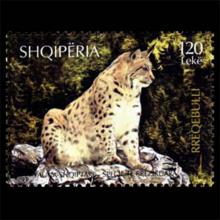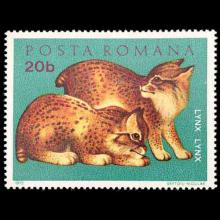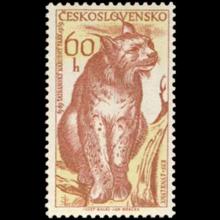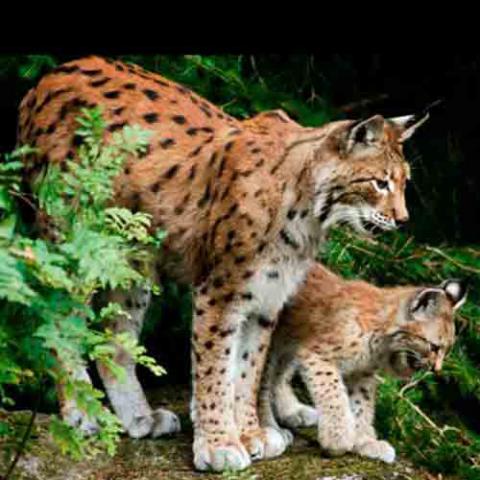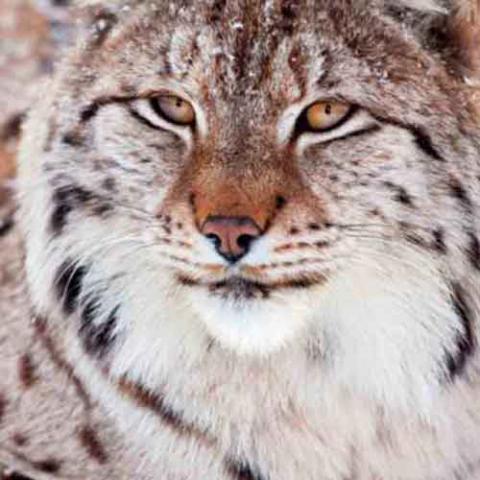NAMES
TAXONOMY
Afghanistan
Issued:
Stamp:
Lynx lynx
Czechoslovakia
Issued:
Stamp:
Lynx lynx
Afghanistan
Issued:
Stamp:
Lynx lynx
Czechoslovakia
Issued:
Stamp:
Lynx lynx
Afghanistan
Issued:
Stamp:
Lynx lynx
Czechoslovakia
Issued:
Stamp:
Lynx lynx
Genus species (Animalia): Lynx lynx
The Eurasian lynx (Lynx lynx) is the largest of the four lynx species, ranging in length from 80 to 130 cm (31 to 51 in) and standing 60–75 cm (24–30 in) at the shoulder. The tail measures 11 to 24.5 cm (4.3 to 9.6 in) in length. Males usually weigh from 18 to 30 kg (40 to 66 lb) and females weigh 8 to 21 kg (18 to 46 lb). Male lynxes from Siberia, where the species reaches the largest body size, can weigh up to 38 kg (84 lb) or reportedly even 45 kg (99 lb). The race from the Carpathian Mountains can also grow quite large and rival those from Siberian in body mass in some cases. It has powerful, relatively long legs, with large webbed and furred paws that act like snowshoes. It also possesses a short "bobbed" tail with an all-black tip, black tufts of hair on its ears, and a long grey-and-white ruff.
During the summer, the Eurasian lynx has a relatively short, reddish or brown coat, which tends to be more brightly colored in animals living at the southern end of its range. In winter, however, this is replaced by a much thicker coat of silky fur that varies from silver-grey to greyish brown. The underparts of the animal, including the neck and chin, are white at all times of the year. The fur is almost always marked with black spots, although the number and pattern of these are highly variable. Some animals also possess dark brown stripes on the forehead and back. Although spots tend to be more numerous in animals from southern populations, Eurasian lynx with heavily spotted fur may exist close to others with plain fur.
Eurasian lynx make a range of vocalizations, but are generally silent outside of the breeding season. They have been observed to mew, hiss, growl, and purr, and, like domestic cats, will "chatter" at prey that is just out of reach. Mating calls are much louder, consisting of deep growls in the male, and loud "meow"-like sounds in the female.
Eurasian lynx are secretive, and because the sounds they make are very quiet and seldom heard, their presence in an area may go unnoticed for years. Remnants of prey or tracks on snow are usually observed long before the animal is seen.
Behavior
Lynx prey largely on small to fairly large sized mammals and birds. Among the recorded prey items for the species are hares, rabbits, marmots, squirrels, dormice, other rodents, mustelids (such as martens), grouse, red foxes, wild boar, chamois, young moose, roe deer, red deer, reindeer and other ungulates. Although taking on larger prey presents a risk to the animal, the bounty provided by killing them can outweigh the risks. The Eurasian lynx thus prefers fairly large ungulate prey, especially during winter when small prey is less abundant. They are the only Lynx species in which ungulates provide a great portion of their diet in relation to lagomorphs or rodents. Where common, roe deer appear to be the preferred prey species for the lynx. Even where roe deer are quite uncommon, the deer are still quantitatively the favored prey species, though in summer smaller prey and occasional domestic sheep are eaten more regularly. In parts of Finland, introduced white-tailed deer are eaten regularly. In some areas of Poland and Austria, red deer are the preferred prey and, in Switzerland, chamois may be locally favored. They will also feed on carrion when it is available. Adult lynx require 1.1 to 2 kilograms (2.4 to 4.4 lb) of meat per day, and may take several days to fully consume some of their larger prey.
The main method of hunting is stalking, sneaking and jumping on prey, although they are also ambush predators when conditions are suitable. In winter certain snow conditions make this harder and the animal may be forced to switch to larger prey. Eurasian lynx hunt using both vision and hearing, and often climb onto high rocks or fallen trees to scan the surrounding area. A very powerful predator, these lynxes have successfully killed adult deer weighing to at least 150 kg (330 lb).
The Eurasian lynx inhabits rugged forested country providing plenty of hideouts and stalking opportunities. Depending on the locality, this may include forest-steppe, boreal forest, and montane forest. In the more mountainous parts of their range, Eurasian lynx will descend into the lowlands in winter, following their prey, and avoiding the deepest snows. They tend to be less common where wolves are abundant, and wolves have been reported to attack and even eat lynx. In Russian forests, the most important predators of the Eurasian lynx are the grey wolf. Wolves kill and eat lynxes that fail to escape into trees. Lynx populations decrease when wolves appear in a region and are likely to take smaller prey where wolves are active. Wolverines are perhaps the most dogged of competitors for kills, often stealing lynx kills. Lynxes tend to actively avoid encounters with wolverines, but may sometimes fight them if defending kittens. Instances of predation on lynx by wolverines may occur, even perhaps on adults, but unlike wolf attacks on lynx are extremely rare if they do in fact occur. One study in Sweden found that out of 33 deaths of lynx of a population being observed, one was probably killed by a wolverine. Another known instance of predation by an adult wolverine on an adult lynx was reportedly seen in the Pechora River area, although this appeared to merely be an anecdotal claim. There are no known instances of lynx preying on a wolverine. Sometimes, Siberian tigers have also preyed on lynxes, as evidenced by examination of tiger stomach contents. Lynx compete for food with the predators described above, and also with the red fox, eagle owls, golden eagles, wild boar (which scavenge from lynx kills), and in the southern part of its range, the snow leopard and leopard as well. Brown bears, although not (so far as is known) a predator of Eurasian lynx, are in some areas a semi-habitual usurpers of ungulate kills by lynxes, not infrequently before the cat has had a chance to consume its kill itself.
Although they may hunt during the day when food is scarce, the Eurasian lynx is mainly nocturnal or crepuscular, and spends the day sleeping in dense thickets or other places of concealment. It lives solitarily as an adult.
The hunting area of Eurasian lynx can be anything from 20 to 450 km2 (8 to 174 sq mi), depending on the local availability of prey. Males tend to hunt over much larger areas than females, which tend to occupy exclusive, rather than overlapping, hunting ranges. The Eurasian lynx can travel up to 20 km (12 mi) during one night, although about half this distance is more typical. They patrol regularly throughout all parts of their hunting range, using scent marks to indicate their presence to other individuals. As with other cats, the scent marks may consist of faeces, urine, or scrape marks, with the former often being left in prominent locations along the boundary of the hunting territory.
Life Cycle
The mating season for Eurasian lynx lasts from January to April. The female typically comes into oestrus only once during this period, lasting from four to seven days, but if the first litter is lost, a second period of oestrus is common. Unlike the closely related Canada lynx, the Eurasian species does not appear to be able to control its reproductive behaviour based on prey availability. This may be because, feeding on a larger range of prey than the Canada lynx, rarity of suitable prey is a less common occurrence.
Pregnant females construct dens in secluded locations, often protected by overhanging branches or tree roots. The den may be lined with feathers, deer hair, and dry grass to provide bedding for the young. Gestation lasts from 67 to 74 days, and results in the birth of from one to four kittens. At birth, Eurasian lynx kittens weigh 240 to 430 grams (8.5 to 15.2 oz) and are blind and helpless. They initially have plain, greyish-brown fur, attaining the full adult colouration around eleven weeks of age. The eyes open after ten to twelve days. The kittens begin to take solid food at six to seven weeks, when they begin to leave the den, but are not fully weaned for five or six months.
The den is abandoned two to three months after the kittens are born, but the young typically remain with their mother until they are around ten months of age (the start of the next breeding season). Eurasian lynx reach sexual maturity at two or three years, and have lived for twenty one years in captivity.
1) The Eurasian lynx is one of the widest ranging cats in the world and can be found in the forests of western Europe, Russia and central Asia.
2) These fur-ocious felines are the largest of the lynx species, and the third largest predator in Europe after the brown bear and the wolf.
3) These incredible cats are strict carnivores, feeding mostly on ungulates (hoofed mammals) such as deer. When food is scarce they also eat smaller prey like hares, foxes and rabbits.
4) The Eurasian lynx can be considered quite a secretive creature. The sounds it makes are very low and often not heard, and their presence in an area can go unnoticed for years!
5) Come meal time, the Eurasian lynx stalks its prey from the cover of thick vegetation. It then pounces on its unsuspecting lunch, delivering a fatal bite to the neck or snout.
6) The Eurasian lynx”s distinctive features are its black tufts at the tips of its ears and a long white facial “ruff”. It has grey, rusty or red fur which grows thicker in winter. Its coat is also patterned, almost always with dark spots.
7) Although they may hunt during the day (particularly when food is scarce), the Eurasian lynx is mainly nocturnal or crepuscular (active during dawn and dusk). They spend the day sleeping in dense vegetation. Zzzzzzzz.
8) The Eurasian lynx measures around 90-110cm in length, and around 60 -70cm in height.
9) In the wild, the Eurasian lynx can survive up to 17 years. Captive Eurasian lynx in sanctuaries have been known to live to up to 24 years.
10) In Europe, the Eurasian lynx was once on the brink of extinction, with numbers falling to around 700 between 1930 and 1950. The good news is that conservation work has allowed populations to bounce – or pounce! – back, with numbers increasing 10-fold over the past 50 years. Yey! Work still needs to be done though, gang, as illegal hunting and habitat loss still pose a threat to these beautiful cats.
Reference
NatGeoKids


